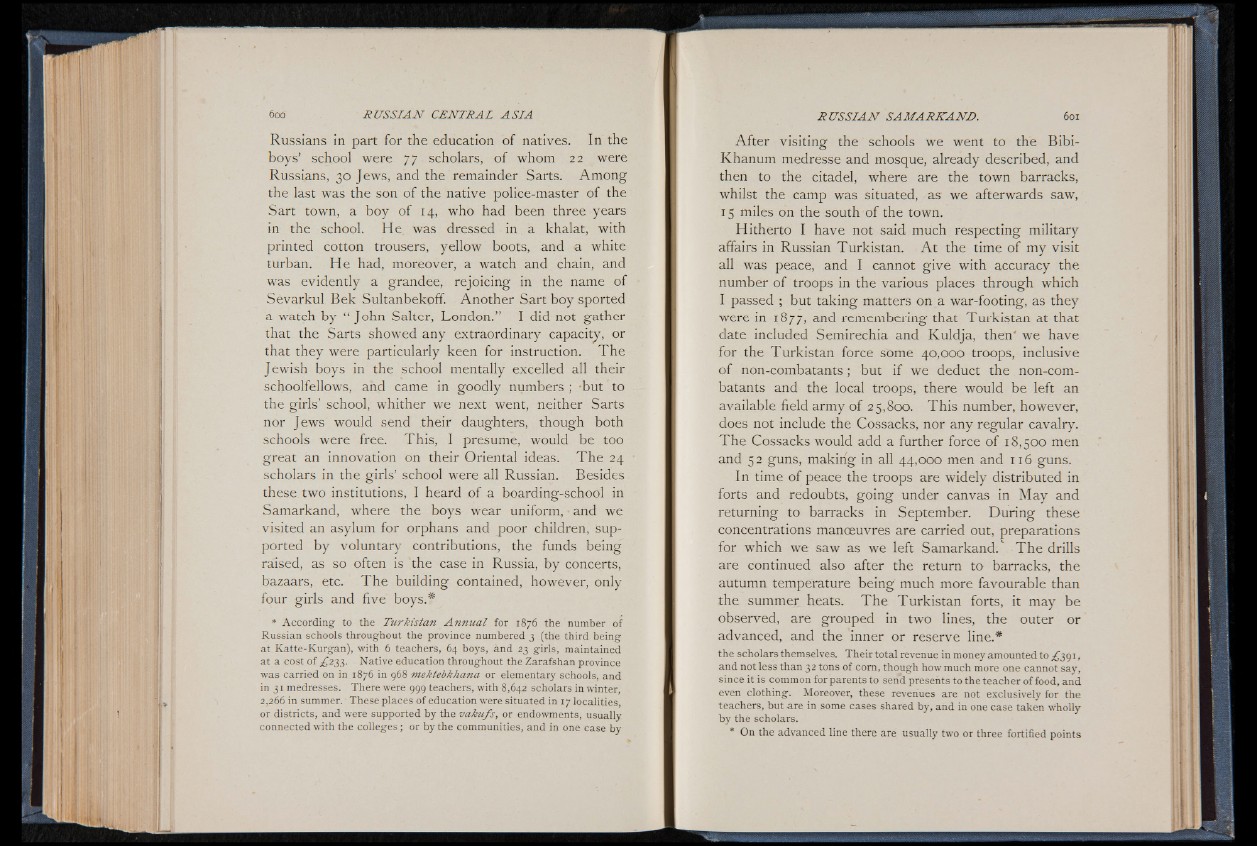
Russians in part for the education of natives. In the
boys’ school were 77 scholars, of whom 22 were
Russians, 30 Jews, and the remainder Sarts. Among
the last was the son of the native police-master of the
Sart town, a boy of 14, who had been three years
in the school. He. was dressed in. a khalat, with
printed cotton trousers, yellow boots, and a white
turban. He had, moreover, a watch and chain, and
was evidently a grandee, rejoicing in the name of
Sevarkul Bek Sultanbekofif. Another Sart boy sported
a watch by “ John Salter, London.” I did not gather
that the Sarts showed any extraordinary capacity, or
that they were particularly keen for instruction. The
Jewish boys in the school mentally excelled all their
schoolfellows, and came in goodly numbers ; -but to
the girls’ school, whither we next went, neither Sarts
nor Jews would send their daughters, though both
schools were free. This, I presume, would be too
great an innovation on their Oriental ideas. The 24
scholars in the girls’ school were all Russian. Besides
these, two institutions, I heard of a boarding-school in
Samarkand, where the boys wear uniform, • and we
visited an asylum for orphans and poor children, supported
by voluntary contributions, the funds being
raised, as so often is the case in Russia, by concerts,
bazaars, etc. The building contained, however, only
four girls and five boys.*
* According to the Turkistan Annual for 1876 the number of
Russian schools throughout the province numbered 3 (the third being
at Katte-Kurgan), with 6 teachers, 64 boys, and 23 girls, maintained
at a cost of ^233. Native education throughout the Zarafshan province
was carried on in 1876 in 968 mektebkhana or elementary schools, and
in 31 medresses. There were 999 teachers, with 8,642 scholars in winter,
2,266 in summer. These places of education were situated in 17 localities,
or districts, and were supported by the vakufs, or endowments, usually
connected with the co lleg e s ; or by the communities, and in one case by
After visiting the schools we went to the Bibi-
Khanum medresse and mosque, already described, and
then to the citadel, where are the town barracks,
whilst the camp was situated, as we afterwards saw,
15 miles on the south of the town.
Hitherto I have not said much respecting military
affairs in Russian Turkistan. A t the time of my visit
all was peace, and I cannot give with accuracy the
number of troops in the various places through which
I passed ; but taking matters on a war-footing, as they
were in 1877, and remembering that Turkistan at that
date included Semirechia and Kuldja, then' we have
for the Turkistan force some 40,000 troops, inclusive
of non-combatants ; but if we deduct the non-combatants
and the local troops, there would be left an
available field army of 25,800. This number, however,
does not include the Cossacks, nor any regular cavalry.
The Cossacks would add a further force of 18,500 men
and 52 guns, making in all 44,000 men and 116 guns.
In time of peace the troops are widely distributed in
forts and redoubts, going under canvas in May and
returning to barracks in September. During these
concentrations manoeuvres are carried out, preparations
for which we saw as we left Samarkand/ The drills
are continued also after the return to barracks, the
autumn temperature being much more favourable than
the summer heats. The Turkistan forts, it may be
observed, are grouped in two lines, the outer or
advanced, and the inner or reserve line.*
the scholars themselves. Their total revenue in money amounted to ^391,
and not less than 32 tons of com, though how much more one cannot say,
since it is common for parents to send presents to the teacher of food, and
even clothing. Moreover, these revenues are not exclusively for the
teachers, but a re in some cases shared by, and in one case taken wholly
by the scholars.
* On the advanced line there are usually two or three fortified points